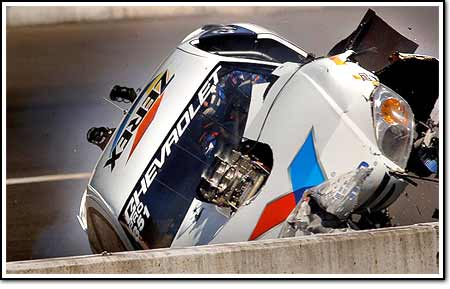NEWS & ANALYSIS
Safety: What a concept
Words by Glen Grissom
Photo by Mark Rebilas
6/15/06
Although being rebuffed with it’s “too early” to discuss the particulars by the groups involved, sources report that GM and the NHRA are working together on constructing a Pro Stock concept “safety” car. Work has progressed on this concept race car on paper, and GM and various drag racing vendors are contributing to its construction, with the NHRA being involved along the way.
The concept race car’s purpose is to incorporate as much as possible (and practical) of the state of the art in racing safety and driver protection design philosophy from the ground up in a Pro Stock car – with the ultimate goal of getting the NHRA’s blessing of these safety techniques (in the rule book) and building Pro Stock cars that incorporate them. The concept race car’s public unveiling is scheduled for later the season after the NHRA gives it the once (or twice) over. Maybe as late as the end of the year.
“The circus is no fun if all the animals are dead, “ stock car racer Lake Speed summed up the central premise of racing safety a few years back, and the message is valid in drag racing. Bruce Allen and Kenny Koretsky’s wicked Pro Stock crash at the Texas Motorplex last year was yet another case of drag racing drivers cheating death or life-changing serious injury – and it seemed like Fate had more to do with their survival than their cars’ construction.
Watching Allen’s car explode into so much swirling junk also helped serve as motivation for a “quiet” in-house project at GM, working along with the NHRA, which will likely face public display and scrutiny in the second half of the NHRA season.
After that metal-shredding, highlight-reel Pro Stock crash, the GM drag racing engineers and marketing people held what might be called“magic wand” meetings. They collaborated on laying down a “what if” specification for a better, safer, Pro Stock car – incorporating as many safety and driver protection attributes as they know, and could feasibly produce in a raceable Pro Stock car.
GM is taking a giant step forward in drag racing safety by committing its resources and reputation to this concept vehicle. Keep in mind that this is the manufacturer that first put crash recorders (measuring G loads) in race cars in 1993. The real-world data they recorded was invaluable in the Indy car ranks to help redesign those cars to improve driver survivability. They are not late-comers to racing safety, and in fact have a full time engineer, Tom Gideon, whose only job is racing safety.
He has as his primary credo to make sure that any change to the safety status quo will do no harm. GM can offer validation of a safety concept, and facilities for testing it, which equal confidence in any safety-related change. Thus, a sanctioning body can sign off on it and incorporate it into its rules.
Pursuing such a proactive and public approach to driver safety is not the norm in racing, and GM should be commended for their leadership and cooperative role. Make no mistake, the NHRA does not have to enact any of the changes that GM proposes and will incorporate in this concept race car, but by working together so there are no surprises for the sanctioning body, the likelihood of approval is increased. At the very least, GM and the NHRA are fostering a safety dialogue about these cars, and perhaps future action.
GM is not doing all this alone -- they don’t have an in-house Pro Stock chassis-building shop – at least not one that we know of. Various racing aftermarket manufacturers and vendors are also involved with them and are donating their parts and construction time to this car – you can bet their names will be on some signage when the concept race car does go on display.
This is not the first time that GM has built an educational “safety” concept racing car for a series. They collaborated on a similar one and displayed it when they were heavily involved in the ASA stock car racing series back in 2000. The crew chiefs in that series swarmed all over it to gather ideas on how to improve the safety characteristics of their cars.
Nor is it the first time they have taken a proactive safety approach in the NHRA – GM Racing produced a videotape in 2004 entitled, “Why You Should Wear A HANS Device” and distributed it to the drivers in the top drag racing classes to help educate them, and their families, about the merits of a head and neck restraint. They applied the same educational muscle in the NASCAR top ranks, too.
From a cold, hard cash perspective, it’s just plain good business for GM (and the NHRA) to protect their drivers and fans – think of the investment they both have in Bruce Allen, for example, or Warren Johnson for that matter, and all those people in the seats. Here’s to seeing the features of GM’s safety concept Pro Stock car being applied and contributing to driver longevity.![]()